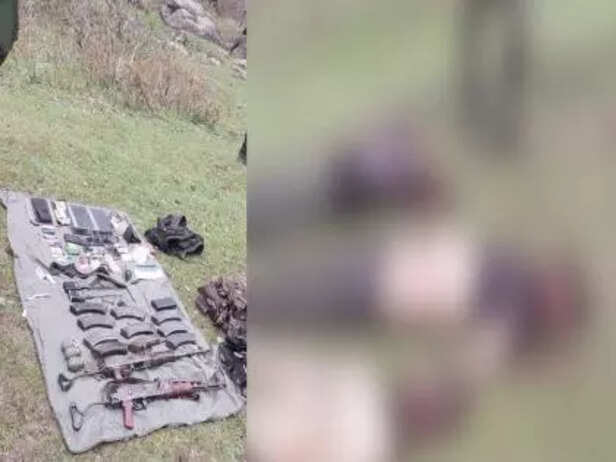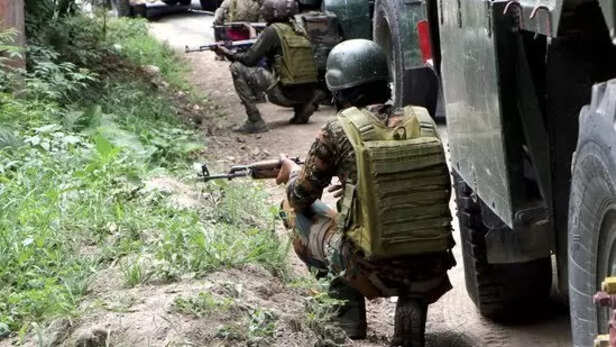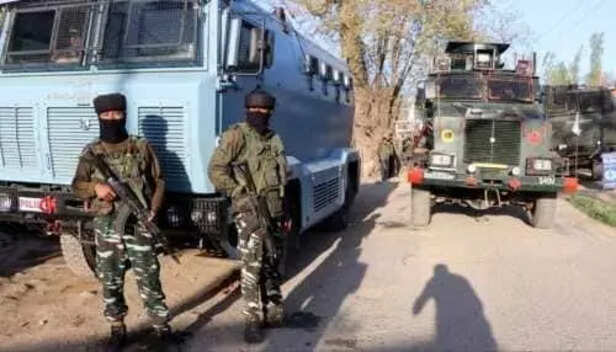Operation Keller—The Next Big Move by the Indian Military After Operation Sindoor
Ankit Gupta | May 13, 2025, 23:15 IST

Operation Keller was a targeted counter-terrorism mission conducted by Indian security forces on May 13, 2025, in the dense forests of the Keller area in Shopian district, South Kashmir. The operation aimed to neutralize militants affiliated with the Pakistan-backed group Lashkar-e-Taiba (LeT) and its proxy, The Resistance Front (TRF).
In the turbulent geopolitical theatre of Kashmir, where conflict, militancy, and diplomacy collide with unpredictable regularity, the Indian military has once again demonstrated strategic prowess and swift retaliation through Operation Keller. Coming right on the heels of Operation Sindoor, this high-risk mission marks not just a continuation but a significant escalation in India’s internal counter-terrorism doctrine. While Operation Sindoor showcased India's will to strike across the border in retaliation for brutal terrorist attacks, Operation Keller reaffirmed India's unyielding resolve to root out the remnants of terror from within its own soil — surgically, swiftly, and with calculated precision.
The genesis of Operation Keller can be traced back to April 22, 2025, when India witnessed one of the deadliest terrorist attacks in the past five years. A group of armed militants ambushed a group of Hindu pilgrims and local civilians in Pahalgam, Anantnag district, leaving 26 dead and dozens injured. The attack sent shockwaves across the country, igniting public outrage and intense political pressure for a decisive response. The brutality of the act, paired with its symbolic timing just before summer pilgrimages, was designed to sow communal discord and internationalize the Kashmir issue once again.
The terrorists behind this attack were not mere foot soldiers. Intelligence soon confirmed the involvement of The Resistance Front (TRF) — a proxy outfit backed by Lashkar-e-Taiba (LeT) and funded and directed by Pakistan's notorious ISI.
This set the stage for Operation Sindoor, an audacious cross-border air and artillery strike targeting terror camps in Pakistan-occupied Kashmir (PoK). But the Indian military knew the external strike would not suffice unless the internal venom of terrorism was dealt with equally ruthlessly.

Operation Keller, named after the Keller forests in the Shopian district of South Kashmir, was a surgical anti-terrorist mission carried out on May 13, 2025. It was spearheaded by a joint task force comprising the Indian Army’s Rashtriya Rifles, CRPF, and Jammu & Kashmir Police’s Special Operations Group (SOG). The operation’s goal was to neutralize three high-profile terrorists hiding in the Shoekal Keller forest belt — a region notorious for offering safe sanctuary due to its rugged terrain and dense canopy.
This was not a standard cordon-and-search operation. It was a precision strike based on real-time intelligence, drone surveillance, and meticulous planning — hallmarks of a military now embracing next-gen hybrid warfare.
Among the three neutralized terrorists, the most significant was Shahid Kuttay, a TRF commander and the mastermind behind the Pahalgam massacre. A resident of Kulgam district, Kuttay had become the poster boy of the new generation of hybrid terrorists — those who mix civilian life with terror activities, making it harder for security forces to identify them until it’s too late.
Also eliminated were:
These individuals were not low-level operatives but key cogs in Pakistan's proxy warfare machine, with Kuttay having direct links to ISI handlers across the border.

The entire operation was wrapped up within six hours — from pre-dawn intelligence validation to final body recoveries.
This operation was not only militarily successful but also symbolically powerful — showcasing India’s ability to hit terror at its root with zero tolerance, zero delay, and zero error.

Operation Keller wasn’t just a tactical strike. It was a loud message to Pakistan’s military-jihadi complex. While diplomatic channels continue to talk ceasefires, India has drawn a line — terrorism and diplomacy cannot co-exist.
By eliminating Shahid Kuttay — a known Pakistani asset — on Indian soil, the message is unmistakable: India is now prepared to uproot terror at all levels — underground cells, sleeper modules, ideological recruiters, and across-the-border controllers.
This dual-theatre strategy — Sindoor and Keller — is likely to become the template for future Indian responses, where external and internal enemies are tackled simultaneously.
Interestingly, Operation Keller saw no protests, no local unrest, and no stone-pelting — a clear sign that the local population is fatigued by terrorism and wants peace to return.
Local Shopian residents were seen praising the forces for ensuring civilian safety and even providing tip-offs. This points toward a growing shift in the Valley's mindset, especially among the youth, tired of Pakistan's manipulative jihad factory.
Also notable was the army’s post-operation civilian outreach, with medics treating villagers, and food kits distributed — efforts aimed at winning hearts, not just battles.
The Shadow Cast by Pahalgam Massacre
The terrorists behind this attack were not mere foot soldiers. Intelligence soon confirmed the involvement of The Resistance Front (TRF) — a proxy outfit backed by Lashkar-e-Taiba (LeT) and funded and directed by Pakistan's notorious ISI.
This set the stage for Operation Sindoor, an audacious cross-border air and artillery strike targeting terror camps in Pakistan-occupied Kashmir (PoK). But the Indian military knew the external strike would not suffice unless the internal venom of terrorism was dealt with equally ruthlessly.
What is Operation Keller?

3 Terrorist were Shot in the Head
Operation Keller, named after the Keller forests in the Shopian district of South Kashmir, was a surgical anti-terrorist mission carried out on May 13, 2025. It was spearheaded by a joint task force comprising the Indian Army’s Rashtriya Rifles, CRPF, and Jammu & Kashmir Police’s Special Operations Group (SOG). The operation’s goal was to neutralize three high-profile terrorists hiding in the Shoekal Keller forest belt — a region notorious for offering safe sanctuary due to its rugged terrain and dense canopy.
This was not a standard cordon-and-search operation. It was a precision strike based on real-time intelligence, drone surveillance, and meticulous planning — hallmarks of a military now embracing next-gen hybrid warfare.
The Targets: Masterminds of Mayhem
Also eliminated were:
- Adnan Shafi Dar – A known Lashkar-e-Taiba (LeT) cadre and bomb expert trained in Pakistan.
- Haris Nazir – A radicalized youth from Pulwama, part of the sniper unit trained to carry out high-precision attacks on tourists and pilgrims.
How the Operation Unfolded

Indian Army soldiers stand guard at an encounter site
The entire operation was wrapped up within six hours — from pre-dawn intelligence validation to final body recoveries.
Key Features:
- Intelligence-Led: The Jammu & Kashmir Police's intelligence wing intercepted a satellite phone call traced to the Keller region, confirmed via UAV (drone) imagery.
- Silent Infiltration: Teams were heli-dropped at strategic ridgelines during the night to silently surround the dense forested valley, cutting off all escape routes.
- Precision Engagement: By 4:30 AM, after establishing visual confirmation through heat-signature scans, snipers from the Army’s Para SF opened fire, forcing the terrorists into defensive positions.
- Firefight: The encounter lasted over two hours. Despite being heavily armed, the terrorists were outmatched in tactical positioning and firepower.
- Zero Collateral Damage: No civilian casualties, no soldier fatalities — a rare outcome in such volatile terrain.
Message to Pakistan

Deterrence Has Teeth Now
Operation Keller wasn’t just a tactical strike. It was a loud message to Pakistan’s military-jihadi complex. While diplomatic channels continue to talk ceasefires, India has drawn a line — terrorism and diplomacy cannot co-exist.
By eliminating Shahid Kuttay — a known Pakistani asset — on Indian soil, the message is unmistakable: India is now prepared to uproot terror at all levels — underground cells, sleeper modules, ideological recruiters, and across-the-border controllers.
This dual-theatre strategy — Sindoor and Keller — is likely to become the template for future Indian responses, where external and internal enemies are tackled simultaneously.
Civilian Impact and Perception in Kashmir
Local Shopian residents were seen praising the forces for ensuring civilian safety and even providing tip-offs. This points toward a growing shift in the Valley's mindset, especially among the youth, tired of Pakistan's manipulative jihad factory.
Also notable was the army’s post-operation civilian outreach, with medics treating villagers, and food kits distributed — efforts aimed at winning hearts, not just battles.
